 Alternative SSE deployment topologies 5.0
Alternative SSE deployment topologies 5.0
Authors: ThomasPiccoli, GrantCovell Build basis: The Rational solution for systems and software engineering (SSE), version 5.0, 5.0.1, 5.0.2
- Standard topologies overview
- (SSE-E0) Enterprise - Middleware and OS not specified
- (SSE-E3) Enterprise distributed Red Hat Enterprise Linux (RHEL) with DB2
- (SSE-D0) Departmental – Middleware and OS not specified
- (SSE-D1) Departmental Windows with DB2
- (SSE-D5) Departmental Red Hat Enterprise Linux (RHEL) with Oracle
- (SSE-V1) Evaluation Windows, Tomcat and Derby
- Applying the topologies
- Datasheets and sizing guidelines
- Next steps
Standard topologies overview
This page describes the Alternative SSE Deployment Topologies for version 5.x. Refer to Standard deployment topologies overview for high-level description of the standard topologies, how they are categorized and their key characteristics.
These alternative deployment topologies for the Rational solution for systems and software engineering (SSE) 5.0 are a subset of the standard SSE deployment topologies. For the rest of the standard topologies, see Recommended SSE deployment topologies 5.0.
As of 5.0.1 new installs can share a single instance of JRS. RELM no longer requires a separate instance of JRS installed with a context root of SPARQL_Gateway.
As of 5.0.2 the Lifecycle Project Administration (LPA) application has been incorporated into the Jazz Team Server. It is no longer delivered as a separate WAR application.
(SSE-E0) Enterprise - Middleware and OS not specified
Warning: DCC should not be installed if DOORS is the RM provider as data warehouse conflicts will occur. Instead configure the standard ETL jobs for all tools that contribute to the data warehouse.
| Metadata Variable | Value |
| Operating System | not specified |
| Database Management System | not specified |
| Application Server | not specified |
| License Management System | Floating |
| User Management System | Tivoli Directory Server and Microsoft Active Directory |
| Other technologies | Reverse Proxy |
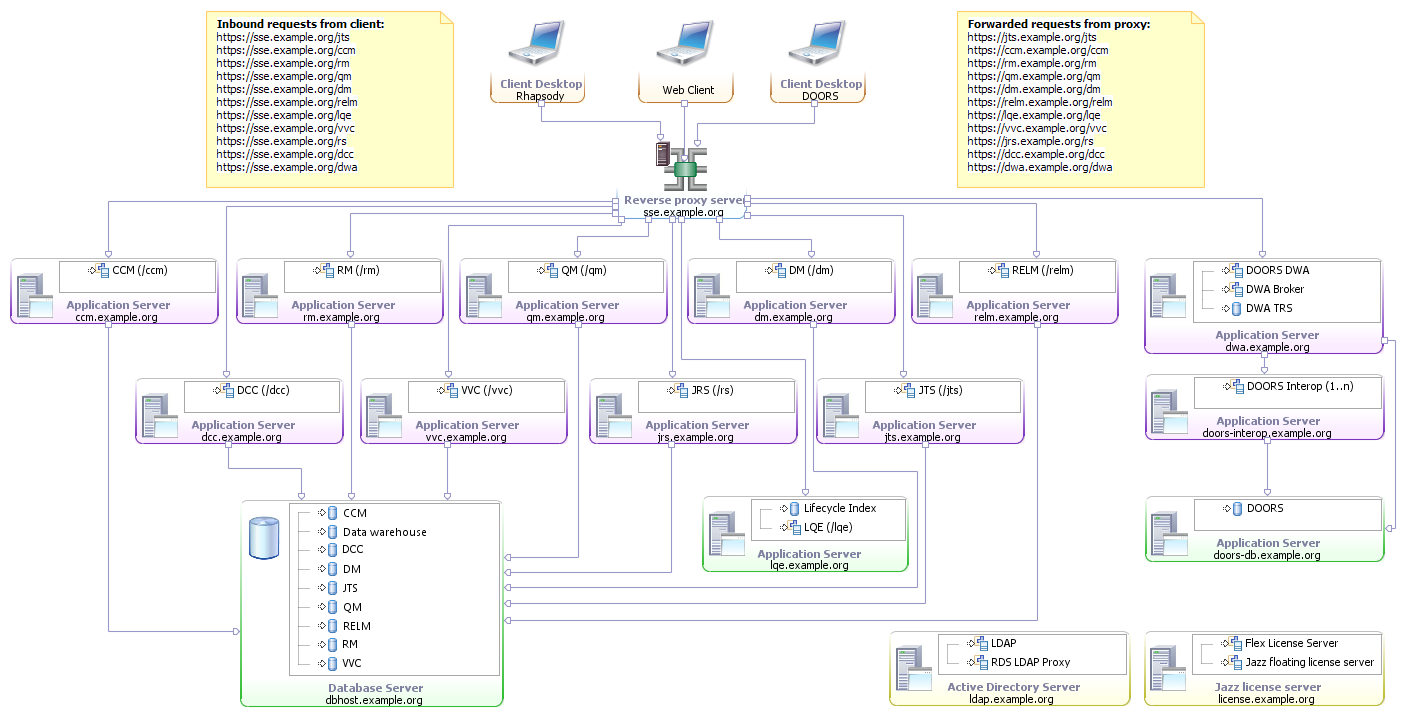
(SSE-E0) Enterprise - Middleware and OS not specified
(SSE-E3) Enterprise distributed Red Hat Enterprise Linux (RHEL) with DB2
This enterprise topology uses Linux for the server operating systems. The applications are distributed across separate servers and WAS instances. A reverse proxy is used to ensure public URI stability. DB2 is used for the databases and is hosted on a separate server. Finally, licenses are served by a floating license server and Tivoli Directory Server provides the LDAP based user management, for all but DOORS/DWA, which uses Windows Active Directory Server.
Note: There have been incidences of the DWA Interops core dumping when processing an RQM Reconcile operation on Linux. To avoid this issue the DWA Interops should be run on a Windows server. This issue is currently under investigation in APAR PI08809 (http://www.ibm.com/support/docview.wss?uid=swg1PI07809)
Warning: DCC should not be installed if DOORS is the RM provider as data warehouse conflicts will occur. Instead configure the standard ETL jobs for all tools that contribute to the data warehouse.
| Metadata Variable | Value |
| Operating System | RHEL |
| Database Management System | DB2 |
| Application Server | WAS |
| License Management System | Floating |
| User Management System | Tivoli Directory Server and Microsoft Active Directory |
| Other technologies | Reverse Proxy |
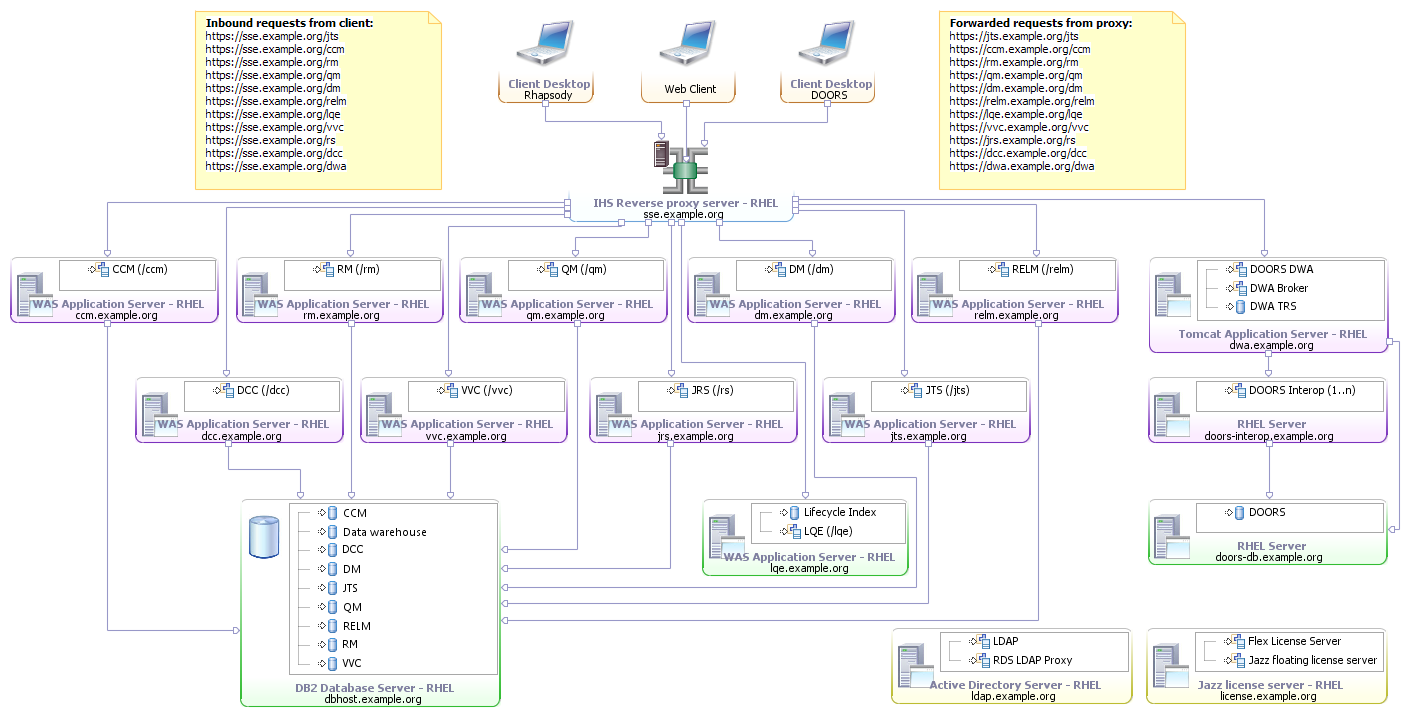
(SSE-E3) Enterprise distributed Red Hat Enterprise Linux (RHEL) with DB2
| Server | Software |
| 1 | JTS, WAS |
| 2 | CCM, WAS |
| 3 | QM, WAS |
| 4 | RM, WAS |
| 5 | DCC, WAS |
| 6 | RS, WAS |
| 7 | DM, WAS |
| 8 | RELM, WAS |
| 9 | VVC, WAS |
| 10 | LQE, WAS |
| 11 | DOORS DB |
| 12 | DWA, Broker, Tomcat |
| 13 | DOORS Interops (1..n) |
| 14 | DB2 |
| 15 | IHS Reverse Proxy Server |
| 16 | LDAP Server |
| 17 | License Server |
(SSE-D0) Departmental – Middleware and OS not specified
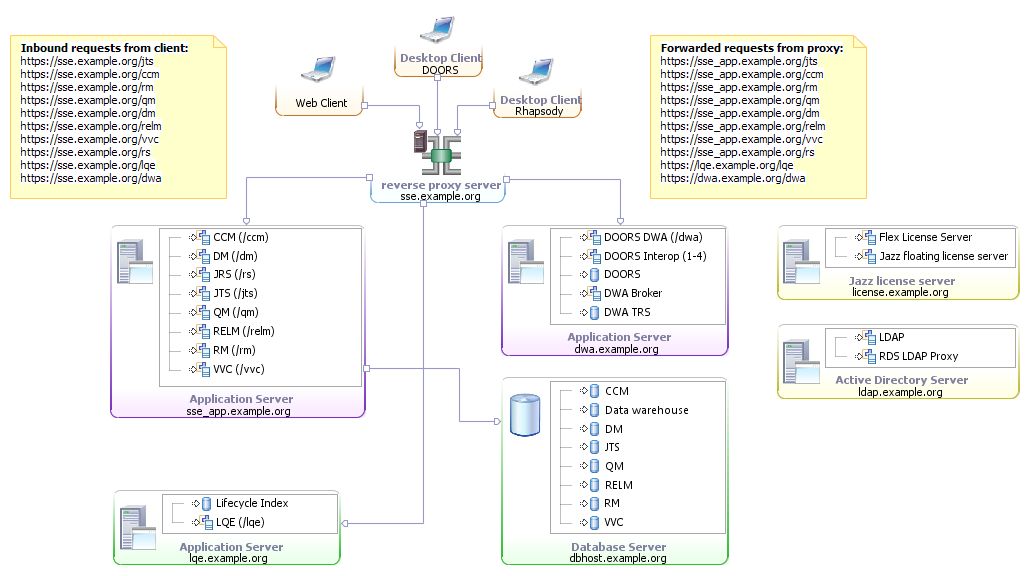
(SSE D0) Departmental - Middleware and OS not specified
(SSE-D1) Departmental Windows with DB2
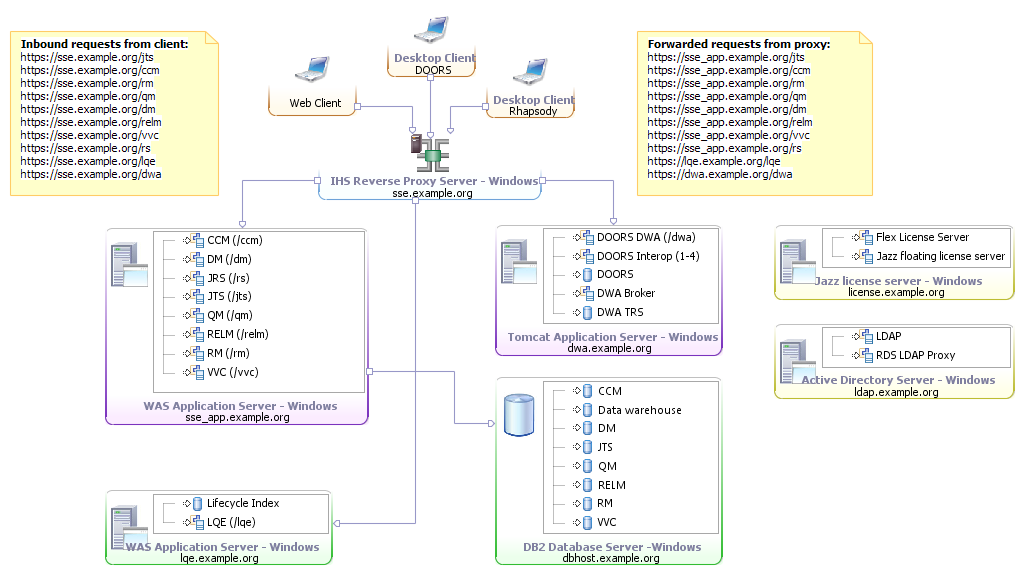
(SSE D1) Departmental Windows with DB2
(SSE-D5) Departmental Red Hat Enterprise Linux (RHEL) with Oracle
Note: There have been incidences of the DWA Interops core dumping when processing an RQM Reconcile operation on Linux. To avoid this issue the DWA Interops should be run on a Windows server. This issue is currently under investigation in APAR PI08809 (http://www.ibm.com/support/docview.wss?uid=swg1PI07809)
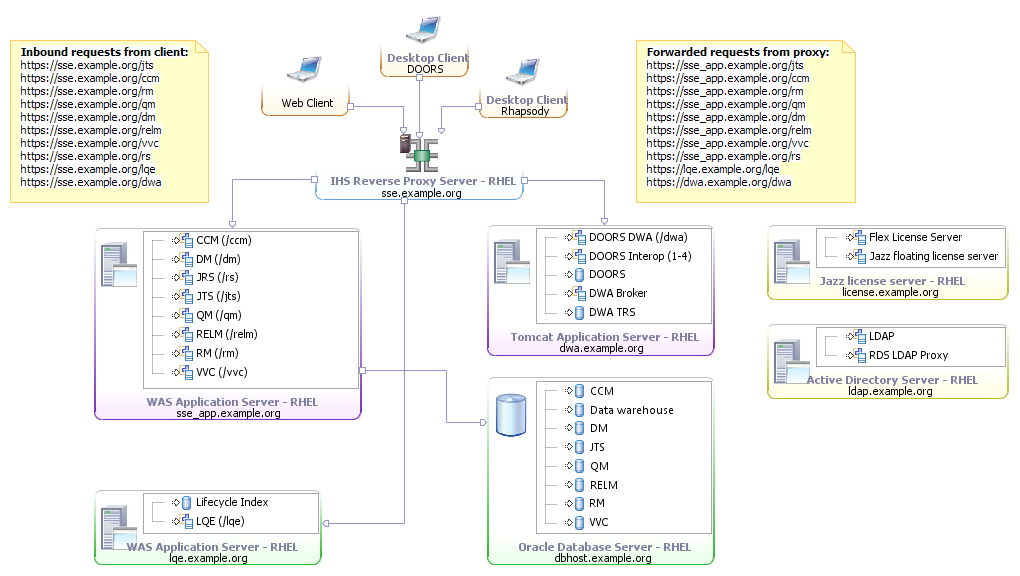
(SSE-D5) Departmental Red Hat Enterprise Linux (RHEL) with Oracle DOORS
(SSE-V1) Evaluation Windows, Tomcat and Derby
Note: The evaluation topology does not meet the demands of a typical production workload because of the limited scalability of the single application server. While this topology is ideal for evaluations, demonstrations, and training purposes realize that the data created in an evaluation topology cannot be transferred to a scalable production environment when the evaluation is complete.
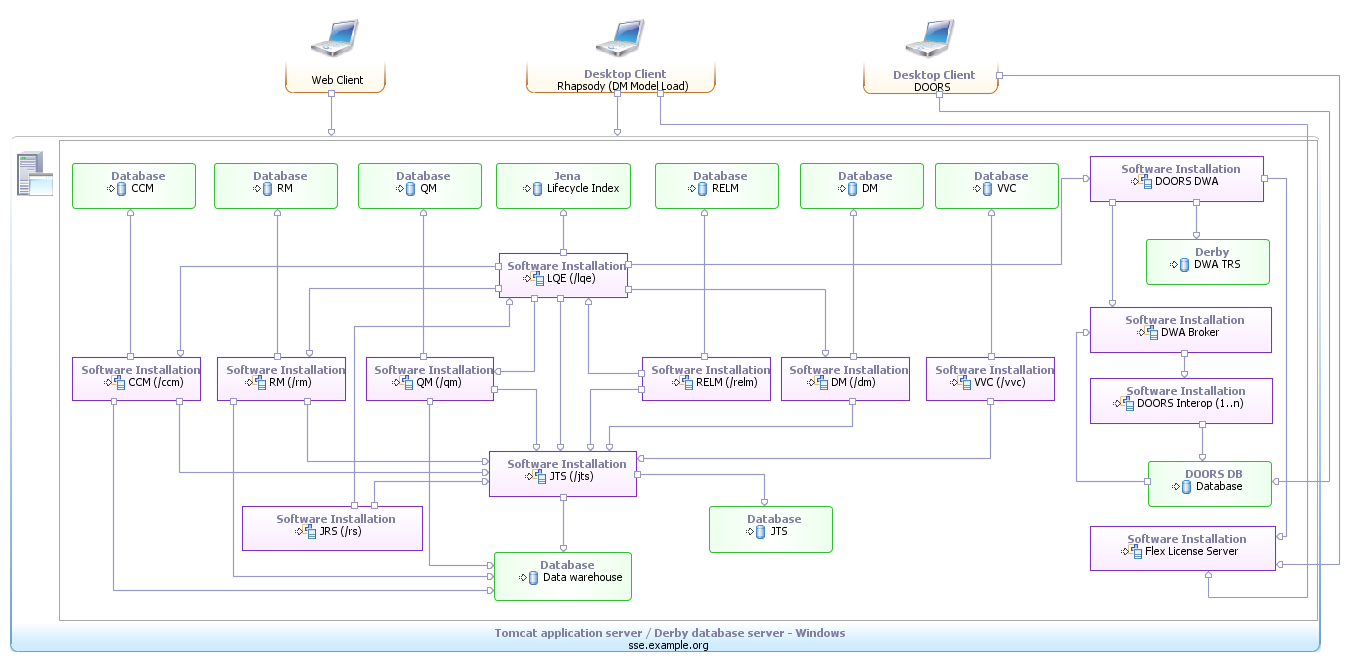
(SSE-V1) Evaluation
Applying the topologies
Every customer's environment is different with unique, necessary and often immutable requirements and constraints. We recognize that these standard topologies may not provide enough detail to make them immediately implementable in some customer environments, but we wanted to describe several topologies with enough variability to give an indication of what is possible and where our recommendations start.
While we recommend customers start with a standard topology that is most applicable to them, we recognize they will need to make changes and customizations to support their own unique requirements and constraints. IBM will support your own implementations, but may ask you to describe which topology is most applicable to your deployment and ask you to document what is unique in your environment to expedite any potential support situation.
To aid you in documenting your chosen deployment topology, we have made the following Rational Software Architect (RSA) model files available:
- CLM standard topologies
- CLM standard topologies 5.0.2
- SSE standard topologies 4.0.3 and 4.0.4
- SSE standard topologies 4.0.5
- SSE standard topologies 4.0.6
- SSE standard topologies 5.0.0
- SSE standard topologies 5.0.1
- SSE standard topologies 5.0.2
These may be imported into RSA then further modified or expanded to represent your environment. Look at the Installation_Instructions.txt file for information on how to import the models into RSA.
Datasheets and sizing guidelines
Find CLM-specific performance datasheets, sizing guidelines and performance-related case studies on the Performance datasheets and sizing guidelines page.
Next steps
This topic is meant to briefly introduce these standard topologies and describe how they might be applied. Work is already underway to build upon and apply them. Subsequent updates to this topic and supporting topics will provide additional insight into their usage.
Future updates to this topic or supporting topics may cover:
- Deeper look at select topologies
- Provide suggested tuning parameters
- Consider high availability database topologies
- Begin to expand this topology model into other domains
- Discussion of strategic integrations with other Rational and non-Rational products.
Related topics:
External links:
- None
Additional contributors: None
-
 Deployment web
Deployment web
-
 Planning and design
Planning and design
-
 Installing and upgrading
Installing and upgrading
-
 Migrating and evolving
Migrating and evolving
-
 Integrating
Integrating
-
 Administering
Administering
-
 Monitoring
Monitoring
-
 Troubleshooting
Troubleshooting
Status icon key:
-
 To do
To do
-
 Under construction
Under construction
-
 New
New
-
 Updated
Updated
-
 Constant change
Constant change
- None - stable page
- Smaller versions of status icons for inline text:
-





Contributions are governed by our Terms of Use. Please read the following disclaimer.
Dashboards and work items are no longer publicly available, so some links may be invalid. We now provide similar information through other means. Learn more here.